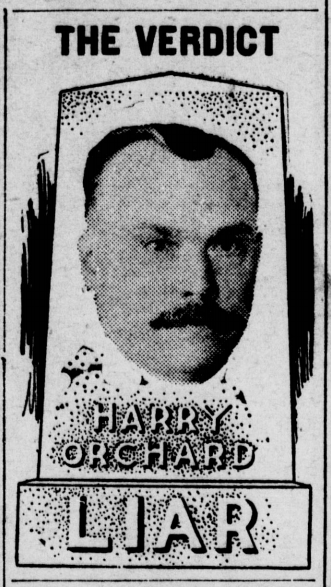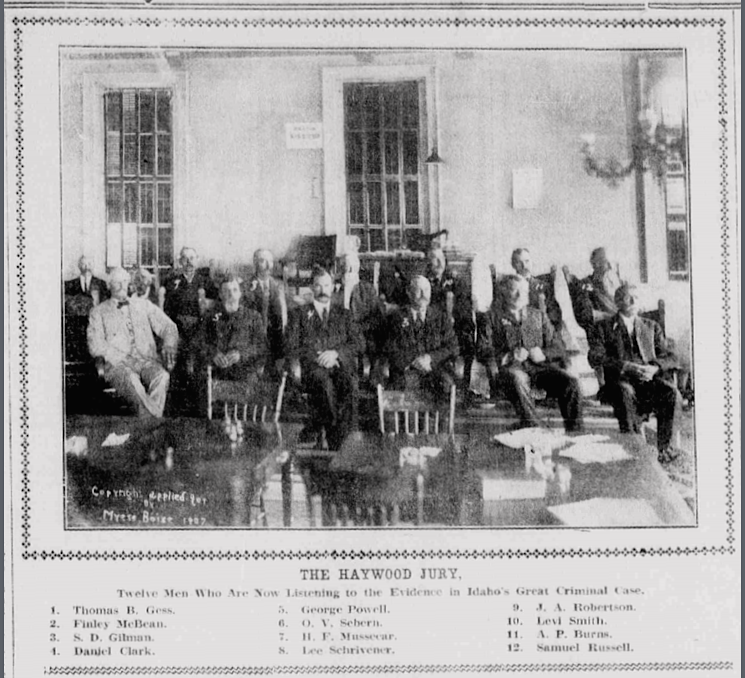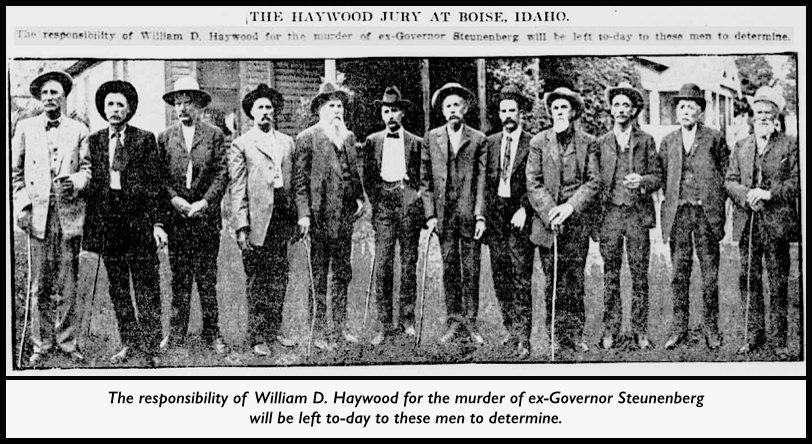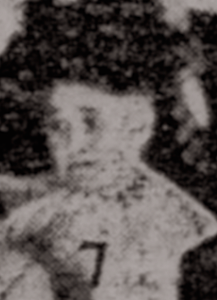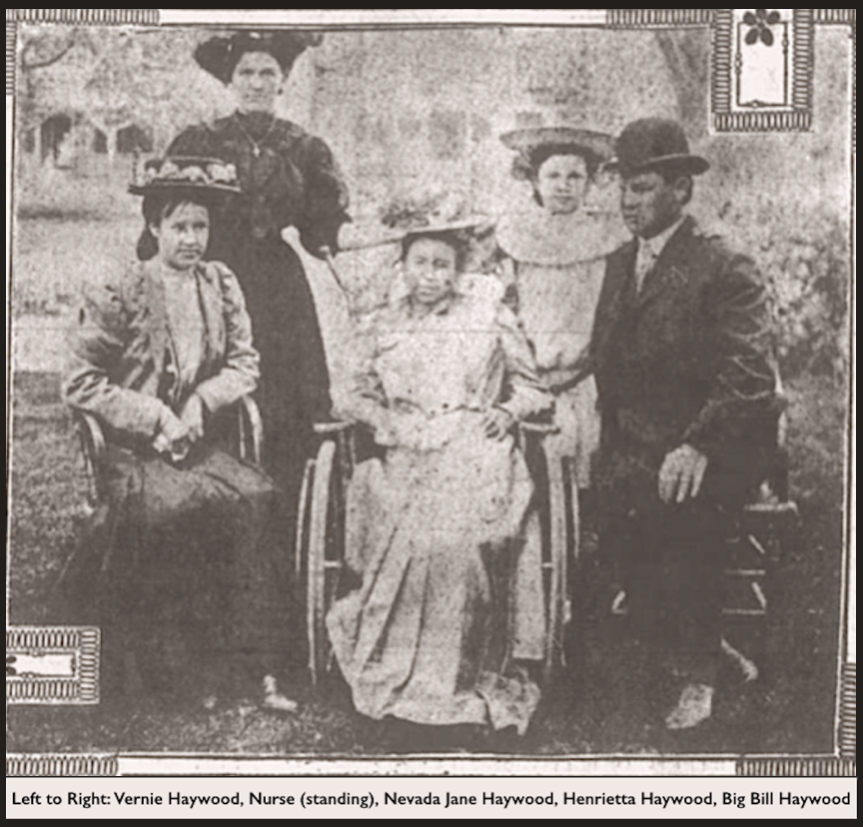powers of privilege will not go
to keep the workers in slavery.
-Mother Jones
Hellraisers Journal, Tuesday July 30, 1907
Boise, Idaho – Haywood Verdict Proves Orchard a Liar
Haywood Awaiting Verdict
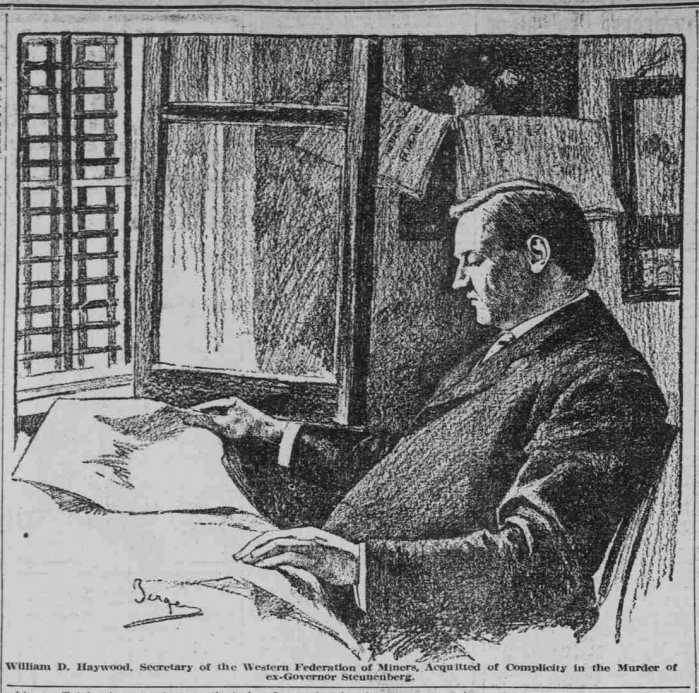
—–
The news of the acquittal of Big Bill Haywood continues to be celebrated by the worker’s of the nation, and by the hard rock miners of the W. F. of M.
The verdict proves the assassin, Harry Orchard, to be a liar and, by extension, the Pinkerton Detective, James McParland, who coached Orchard’s testimony and the state of Idaho who paid for the coaching.
In Boise, a crowd stood vigil at the court house all night long awaiting a verdict. However, it is reported that, while the jury was up all night debating his fate, Big Bill retired at the usual hour Saturday night and slept soundly until he was called to court Sunday morning for the announcement of the verdict.
The Jury
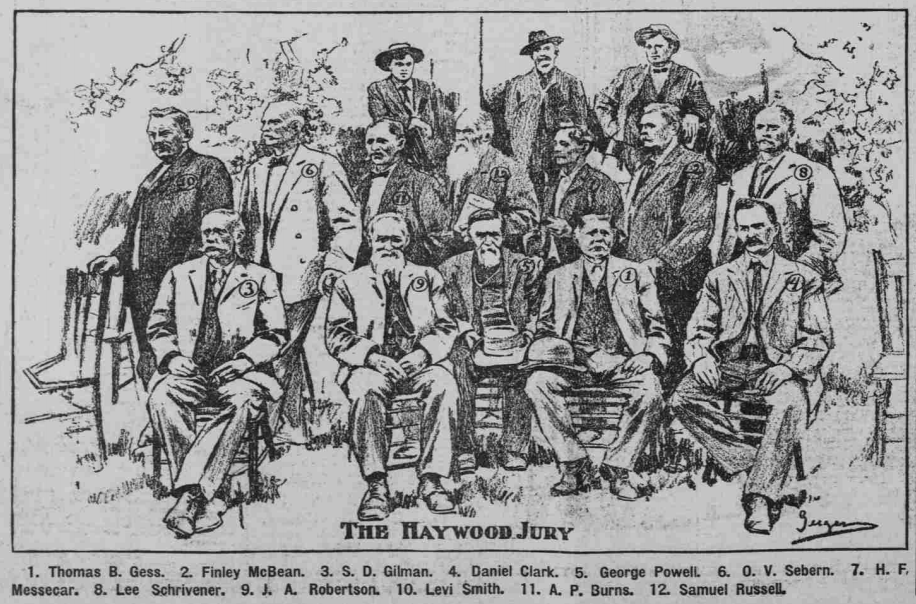
—–
From The Spokane Press of July 29, 1907:
HAYWOOD IS FREE; MOYER OUT ON BAIL
—–
Prosecution Claims Two Remaining Men
Will Be Tried on Original Charge.
—–(United Press Association.)
BOISE, July 29.-Charles A. Moyer, president of the miners’ federation, was released from prison this morning on bail.
George A. Pettibone is still held and the prosecution announces that both will be prosecuted notwithstanding Haywood’s acquittal. Governor Gooding is especially emphatic in declaring that the prosecution will go on.
Haywood is preparing to leave for Denver with his family. He is overcome today with congratulations from all over the country.
With the stillness of the tomb prevailing in the courtroom, and the nerves of those most closely concerned almost at the breaking point, the jury at 8 o’clock yesterday morning returned a verdict of not guilty in the famous trial of William D. Haywood, accused of complicity in the assassination of ex-Governor Steunenberg.
The moment the words were pronounced Haywood seemed to undergo transformation. He was plainly strong and confident when he entered the courtroom, but the terrible strain had told on him heavily and his eye never left the jurymen after they slowly filed into the room.
Amidst the flood of congratulations that poured over the acquitted man Judge Wood formally discharged the defendant and the jury. Haywood left the room as soon as he could and went to the jail, where he told his colleagues, Moyer and Pettibone, and shook hands all round. Then he hurried to St. Luke’s hospital, where his aged mother was suffering critically from worry. His greeting was most affecting and the news of her son’s acquittal had a marvellous effect on the stricken woman.
Then Haywood hurried home to the invalid wife and little daughters who awaited him in the cottage they have occupied since coming to Boise for the trial. That meeting can be poorly imagined and cannot be described. For nearly 2 years the family had been separated. Haywood having been taken from their home at Denver at night and kept in prison under a charge that meant death if sustained.
From statements given out by jurymen the first ballot taken after Thomas Gess had been elected foreman stood 8 for acquittal, 2 for conviction and 2 blank, the latter being cast by Foreman Gess and A. P. Burns. On the second ballot Gess voted for acquittal. Burns followed on the next ballot and there the vote stood for hours, Thomas Powell and S. D. Gilman holding out for conviction in some form.
—–
Shortly before 4 a. m., Sunday, Powell decided to vote for acquittal. Gilman had meanwhile gone to sleep and was not roused until 6 o’clock when another ballot was asked for. Gilman then cast his ballot in favor of Haywood and Judge Wood was notified that an agreement had been reached.
Judge Wood responded promptly and was in his courtroom before the attorneys interested arrived. Haywood was also on hand before Darrow came and told those who spoke to him that he was feeling well and hopeful.
Worn by the 6 weeks of trial and the strain of 21 hours in the stifling jury room wrestling with the verdict, the jury filed slowly into the courtroom and took their places. In the short, interval before Judge Wood asked for the verdict the silence became oppressive and painful. Haywood sat like an image in his chair.
And into that tense moment there crept a slight diversion when Foreman Gess by mistake handed an empty envelope to the court. Judge Wood called the foreman’s attention to the oversight in considerable amazement and Gess then produced the right [one] from another pocket. The court glanced at the verdict and passed it to the clerk, who read it aloud, and the great trial was ended.
One of the interesting developments of the jury session was the fact that Juror James Robertson, at whose home Steunenberg had boarded for a long time and who was a fast friend of the murdered governor, stood for Haywood’s acquittal from the first. He held that under the law and evidence presented there was nothing else to do.
The other jurors who first voted for acquittal held that nothing had been shown but inference and weak circumstantial evidence that was not substantiated. Very few of the jurors appeared to place even slight credence in Orchard’s testimony
———-
[Photograph of jury added.]
The Haywood Jury (a Close-Up)

—–
From The Spokane Press of July 27, 1907:
HAYWOOD’S CASE HAS BEEN GIVEN
TO THE JURY
—–
—–
(United Press Association.)
BOISE, July 27.-The jury that is to decide the fate of Haywood as far as this court is concerned retired to deliberate on the verdict at 11:05 this forenoon.
When the clerk called Haywood to the bar the accused showed for the first lime the terrible strain he is under. His face was drawn and haggard, but still determined.
He gazed wistfully into the face of each juror filing past him in a hopeless endeavor to learn, if possible, how the men who are to decree life or death for him felt.
Everybody connected with the trial was exhausted at the finish by the last 6 weeks of strain and nearly unbearable heat.
The room in which the jury is debating the verdict is a stuffy little apartment measuring 8xl2 feet, furnished with 12 chairs and plain tables. The sun streams down on the roof, adding to the high temperature within.
On the lawn below armed deputies keep back the curious crowds. Many persons tried to get close to the wall to penetrate, if possible, the secrets of the jury room.
BOISE, July 27.-The oratorial efforts of attorneys on both sides in the Haywood trial were set at naught today by Judge Wood who, as presiding judge had the last say. His clear exemplication reduced to dry facts the real kernel of this famous murder case.
Haywood, the court plainly stated, was on trial only for the murder of Steunenberg. On the surface his instructions would seem to favor the defense, but the real fact is that they favor the law of Idaho.
The instructions were probably the most voluminous in the criminal annals of the country. Summing up the case In 15,000 words. Judge Wood insisted that the jury must convict, if at all, after all reasonable doubt had been removed, and he very carefully analyzed what a reasonable doubt is, according to law.
If it is possible for you to reconcile the facts in this case upon any reasonable theory, consistent with the innocence of Haywood, it is your duty to find him not guilty.
The burden on the prosecution to prove conspiracy was formed that in its execution the same parties killed Steunenberg.
The burden is upon the prosecution throughout. It never shifts to the defendant. Therefore if the prosecution failed in each and every one of these facts you should acquit.
You are further instructed that such combination or conspiracy cannot be established by the uncorroborated testimony of an accomplice.
Plunging into Orchard’s evidence the judge went to great pains to show it must be carefully weighed. He said:
The jury is instructed that Orchard claims he is an accomplice in the commission of the offense charged. Under the statute this person cannot be convicted of crime upon the testimony of an accomplice unless such accomplice is corroborated by other evidence which of itself, without aid from the testimony of the accomplice, tends to connect the defendant with commission of the offense charged.
Corroboration is not sufficient if it merely shows commission of the offense and circumstances thereof. The law views with distrust the testimony of an accomplice on account of the motive he may have for laying responsibility of his crime on another, when by so doing he may secure immunity for his own participation.
If you believe from the evidence Orchard was induced or influenced to testify by any promise his testimony should be received by the jury with caution and scrutinized with great care. Unless there is some evidence other than the evidence of Orchard there can be no conviction.
It is not necessary, however, that corroborative evidence itself should be sufficient to actually show commission of crime or connect the defendant. It is sufficient if it positively tends to connect defendant with commission of the crime charged.
The judge concluded as follows:
You are instructed that under the indictment in this case, defendant may, if evidence warrants, be convicted of murder in the first degree, murder in the second degree, manslaughter, or you may find him not guilty.
Haywood, surrounded by his entire family, looked decidedly nervous during the reading of the court’s instructions. The courtroom was crowded and the audience maintained breathless silence.
[Photograph added.]
~~~~~~~~~~~~~~~~~~~~~~
From the Brooklyn Daily Eagle of July 28, 1907:
Haywood’s Mother Collapses.
A tragic event of the day was the collapse of Mrs. Etta Carruthers, the aged mother of Haywood. Completely broken down and suffering from nervous prostration she was taken to St. Luke’s Hospital where it was said to-night that, while her condition is not serious, she will require attention for some time. The strain of the long trial has told more keenly on the mother than on any other member of the prisoner’s family. To-day, as the jury retired and as her son was led away to his cell, Mrs. Carruthers clasped her arms about her son’s broad shoulders and tenderly kissed him. This was the only demonstration in the court room which was only half filled as Judge Wood delivered his charge to the jury. Mrs. Haywood the defendant’s invalid wife, has stood the heat and strain of the trial with apparently no ill effects on her delicate health.
[Photograph added.]
From Boise’s Idaho Daily Statesman of July 28, 1907:
Haywood and Family Await Verdict
—–
Mrs. Haywood remained on the grounds all the afternoon [of Saturday July 27th], being moved about occasionally from one place to another in her invalid chair and her noon lunch being brought to her. Later in the afternoon Defendant Haywood was allowed to leave the jail and he spent an hour and a half on the lawn at the side of the jail surrounded by his family.
When seen there by a reporter at 4 o’clock he appeared in a comfortable mood-not worried. He inquired if there were any rumors of events in the jury room, said he had no idea what the verdict would be but did not intend to let his mind rest upon the matter any more than possible.
[Photograph added.]
SOURCES
Bill Haywood’s Book
The Autobiography of William D. Haywood
-by Big Bill Haywood
International Publishers, 1929
https://catalog.hathitrust.org/Record/000859708
See Chapter XIII-The Boise Trial
https://babel.hathitrust.org/cgi/pt?id=mdp.39015050276461;view=image;page=root;size=100;seq=211;num=207
The Spokane Press
(Spokane, WA)
-July 29, 1907
(Also source for image of Orchard within article.)
http://chroniclingamerica.loc.gov/lccn/sn88085947/1907-07-29/ed-1/seq-1/
-July 27, 1907
http://chroniclingamerica.loc.gov/lccn/sn88085947/1907-07-27/ed-1/seq-1/
The Brooklyn Daily Eagle
(Brooklyn, New York)
-July 28, 1907
https://www.newspapers.com/image/57652398/
Idaho Daily Statesman
(Boise, Idaho)
-July 28, 1907, page 1
http://www.genealogybank.com/
IMAGES
Drawings: Haywood Reads at Jail Window
& Haywood Jury
Topeka Daily State Journal of July 29, 1907
http://chroniclingamerica.loc.gov/lccn/sn82016014/1907-07-29/ed-1/seq-6/
HMP, Haywood Jury, DEN June 5, 1907
-& close-up
https://www.newspapers.com/image/73735949/
HMP, Jury Standing, NY Tb July 27, 1907
http://chroniclingamerica.loc.gov/lccn/sn83030214/1907-07-27/ed-1/seq-1/
HMP, Haywood’s Mother, NYTb July 16, 1907
http://chroniclingamerica.loc.gov/lccn/sn83030214/1907-07-16/ed-1/seq-3/
Haywood Family Reunited, Boise, Wilkes-Barre Leader, May 10, 1907
https://www.newspapers.com/image/116462796

